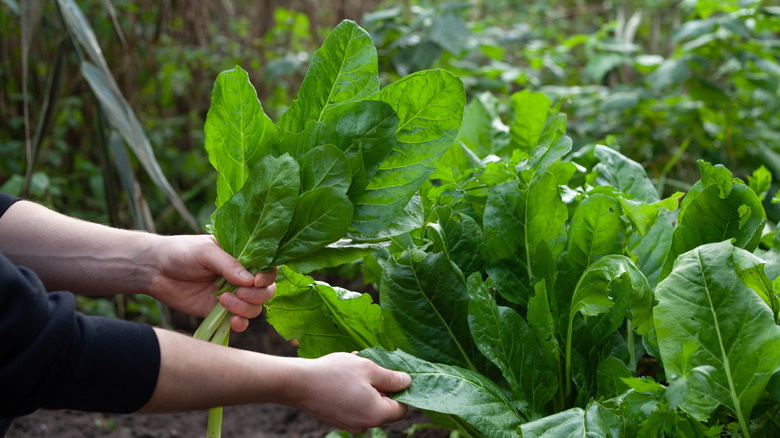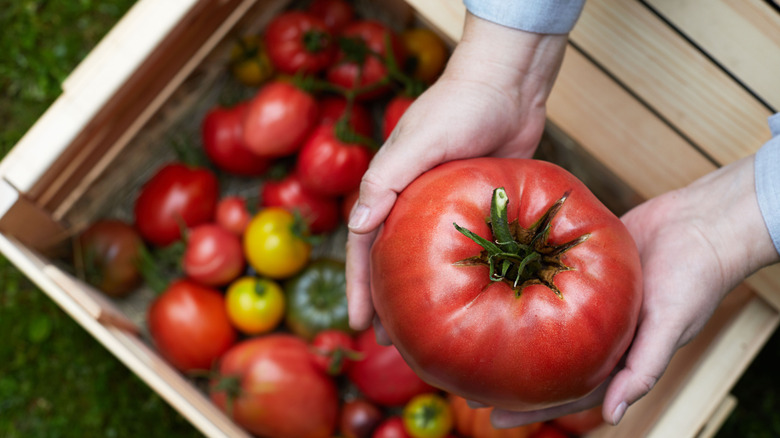How To Grow Extra-Large Vegetables In Your Own Backyard Garden
Imagine a pumpkin so big that it could fit a whole Halloween party. This is exactly what twin brothers Ian and Stuart Paton, lifelong growers from Hampshire, have done. Their gigantic pumpkin, weighing 2,819 pounds, is the biggest pumpkin ever. But do you actually want your vegetables to be so large? Well, no, and here is why. Giant fruits and veggies usually don't taste quite as good. So, as tempting as it sounds, that giant pumpkin pie probably won't be the hit you expect. But still, there is nothing wrong with wanting your veggies to be extra large, and it isn't difficult
All you have to do is try creating a flourishing vegetable garden that provides the best growing conditions for your veggies. But start by choosing the right seed. A plant's size is fundamentally limited by its DNA. So, you want to pick the varieties that are specially bred to grow extra-large fruits and veggies. Those are the seeds you want to begin with. But remember, they are seeds, not magic beans that will grow into towering beanstalks overnight. You'll need to provide the seeds with the right conditions: Soil, water, and nutrients all matter.
Optimizing conditions for growing extra-large vegetables
With the right seeds in place, the next thing to do is to ensure the plant has access to resources. For instance, if you are growing a leafy green, it will need a lot of nitrogen, but for things like pumpkin, phosphorus, and potassium are what you will need the most. You also want to keep an eye out for conditions that could put stress on your vegetable plants. And you cannot let it be too hot, too cold, or too dry. Understanding how much water your vegetables need is also vital. Consistent moisture supports cell expansion, the very process behind plant growth.
It's also important not to overwater. This can put stress on plants, causing stunted growth and leading to smaller produce. Therefore, find out how much water your vegetable actually needs, and make sure the water is accessible to the plant. Ideally, you should set up a drip irrigation system. They will ensure that water gets directly to the roots and reduce the chances of water sitting in a place where it can harbor pests and diseases. Also, it is just one of those features that make every gardener's life easier.
Additionally, be sure to give your veggies plenty of space to grow. When vegetables are crowded, they struggle to reach their full size. This is especially true for underground vegetables because they are hidden beneath the soil, so they will just keep shrinking in silence until you pull them up and realize what's been lost. The right spacing varies, of course, with every type of vegetable you grow.
Caring for your extra-large vegetables till harvest
If you want to grow big, healthy veggies, the right soil and location matter a lot. So, mix in plenty of well-rotted manure or other organic materials with your garden soil before planting to give your veggie plants a nutrient boost. And while you are at it, also test your soil's pH as an imbalanced pH can block nutrient uptake and limit how big the vegetable can actually get. Furthermore, you also want to pick a sunny location for your vegetables. Plants need that light to make food and thrive. So, avoid planting under trees or with shrubs which might block sunlight and compete with your vegetables for water and nutrients.
In addition, make sure the soil is not soggy or compacted which can limit root growth and thus put stress on your vegetable plants. And keep in mind, big vegetables can attract big trouble too. Pests like aphids, slugs, and caterpillars can undo weeks of effort in no time. So, take time each day to inspect your plants for aphids, slugs, or caterpillars. And, if you'd rather not patrol your giant vegetable garden yourself, try planting flowers that attract beneficial insects to the garden. In addition, with big vegetables, some can get so heavy that, without the right support, the stem might break under the weight. So, make arrangements for that, and you can get creative. For instance, old tights work great for holding up big cucumbers or melons. Or use sturdy stakes, trellises, or even slings to lift your vegetables off the ground. Lastly, be patient. It is going to take time, and you will need to plan accordingly.


